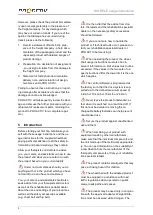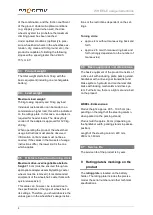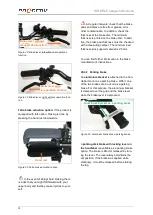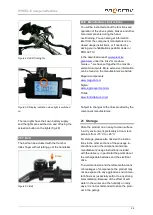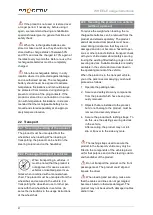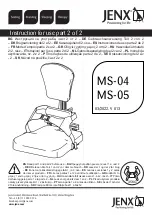
WHEEL-E usage instructions
13
Brake the product using the service
brakes, and activate recuperation when driving
down longer slopes (Chapter 20.5.5), to relieve
the brakes.
The brakes and the drive of the product
may heat up on long trips. Therefore, do not
touch the brakes or the drive during or imme-
diately after the trip.
If the situation allows it, the speed should
be reduced by carefully applying the service
brake. Abrupt braking can cause the upper
body to fall forwards which can thereby result
in injuries or loss of vehicle control.
If the weight load on the drive wheel de-
creases (e.g. when driving on slopes) or when
driving on loose/slippery surfaces, the braking
action of the wheel may be considerably re-
duced. The driving style and speed should be
adjusted so that the product can be safely
stopped at all times using the brakes.
Towing or using a trailer is not permitted.
Make sure that cables and lines are not
kinked or tangled somewhere. This could
cause them to be damaged which could lead to
the brakes and drive system not working cor-
rectly. In this case, the product must no longer
be operated.
14 Safety instructions regarding
obstacles
Driving on steps and escalators with the
product is forbidden.
The maximum obstacle height which can
be negotiated is 10 cm. This value can, how-
ever, be reduced due to the specifications of
the type of wheelchair or its settings. There-
fore, you should observe the values given in
the wheelchair's usage instructions or the re-
strictions dependent on the settings.
When driving over or passing obstacles, it
is important that you avoid any product or body
parts catching on the obstacle as this may lead
to falls causing serious injuries to the user and
third parties as well as damage to the product.
Always drive over curbs or other obsta-
cles so that you cross them to the front or at
right angles and at the minimum required
speed. When approaching an obstacle at an
angle or driving over it with just one wheelchair
wheel, there is an increased risk of tipping over
sideways.
15 Safety instructions regarding
dangerous locations and dan-
gerous situations
The operator of the product determines the
route to be driven themselves, taking the us-
age instructions, their driving knowledge, and
physical abilities into consideration.
Personal driving skills are particularly important
in the following dangerous locations that are
provided as examples; the product user must
use their judgement before driving in such
locations:
quay walls, landing and berthing locations,
paths and locations close to water, unse-
cured bridges and dykes.
narrow paths, slopes (e.g. ramps and
driveways), narrow paths on a slope,
mountainous routes.
narrow and/or steeply sloping paths along
main roads or near cliffs.
routes that are covered in leaves, snow or
ice.
ramps and lifting equipment on vehicles.
When driving in a curve or turning on hills
or downward slopes, there may be an in-
creased tendency to tip over to the side due to
the changes in the centre of gravity. Avoid
such driving manoeuvres. If these cannot be
avoided, perform these driving manoeuvres






